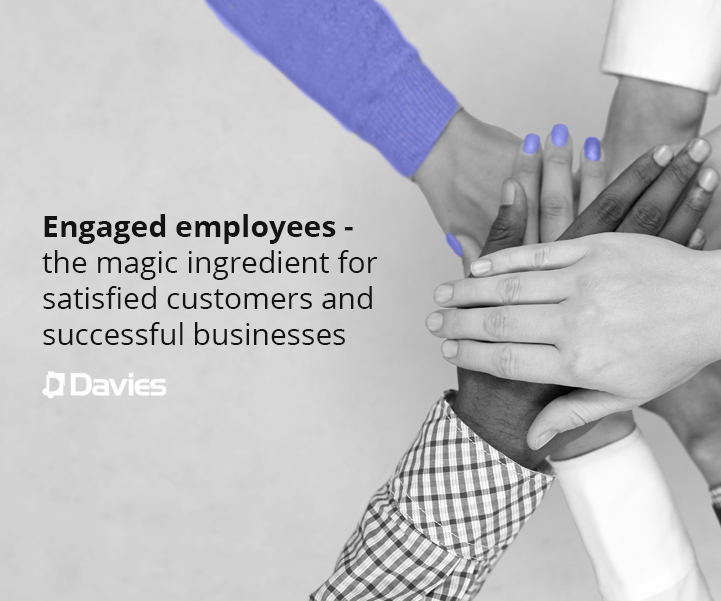Engaged employees – the magic ingredient for satisfied customers and successful businesses
10th May 2019

This was first published by Servicetick, a Davies company.
Over the course of the next couple of weeks, we’ll be posting a series of blogs that look at the crucial role that employees play in delivering great customer experience.
Until recently corporate strategy was based on the principle that, of the three primary stakeholders in a business, the shareholder should take precedence over customers, and employees (if they were considered at all) should come last in the pecking order. There were some notable dissenters to this rule, not least Herb Kelleher the former CEO of Southwest Airlines who believed that:
“Your employees come first. And if you treat your employees right, guess what? Your customers come back, and that makes your shareholders happy. Start with employees and the rest follows from that.”
Fortunately, his view is one that is becoming more and more popular.
WHY EMPLOYEE ENGAGEMENT HAS COME TO THE FORE
Each year, PR firm Edelman publishes its ‘Global Barometer of Trust’. This unique survey measures the level of trust people have in the four main institutions – government, business, media and NGOs. The 2019 survey throws up some startling results for the UK. Less than 50% of the population trust any of the four institutions (with barely a third of us trusting media). However, more than 7 in 10 of us (73%) say that we trust our employer. Trust, it seems, is being focused on those with whom we have a direct relationship.
This deeper link between employee and employer is further evidenced by another revelation from the Edelman report. Two thirds (65%) of us believe the greatest obligation for business (excluding making a profit) is to ‘treat their employees well’. This compares with less than half (47%) who believe that ‘treating customers well’ is the number one priority for a business.
At a time when customer experience has become the overriding focus of most marketing strategies, this may seem a counter-intuitive finding. So it’s worth considering the factors that are driving this stronger connection between company and employee.
Two key themes emerge – technology and pessimism about future prospects.
The threat of automation
Increasing reliance on automation and AI have left many employees feeling dislocated. Mid-tier jobs are being replaced by software and old societal norms of community are overturned by new technology-based interactions. In the field of customer experience, the talk is of chat-bots, artificial intelligence, machine learning, big data, cashless society, apps and omnichannel. All of which threaten the employment prospects of the human population.
Edelman’s Barometer of Trust suggests that as many as 1 in 7 people have real concerns about job prospects reduced because of automation. And the Office for National Statistics (ONS) recently suggested that up to 1.5 million jobs in the UK were at high risk from automation and AI.
While many of the jobs at risk are those that involve manual tasks (operating machines, cleaning, loading, checking) the fear of losing jobs to robots is widespread. In this environment of workplace change and uncertainty, it’s no surprise that those in employment should believe their employer’s primary role is to look after their employee base.
Pessimism about the future
The second driver of the connection between workforce and employer is the public’s pessimism about future prospects. Again according to Edelman (Jan. 2019) nearly half of Brits believe their standard of living will get worse over the next year and a third think their long-term economic prospects will decline. This climate reinforces the need to preserve the status quo.
As employees increasingly turn to the businesses they work for then it is equally true that employers show a growing recognition for the value of the human capital that walks in and out of their offices/factories/workplaces each day.
WHY EMPLOYEE ENGAGEMENT MATTERS
The Institute of Customer Service identified nine trends for customer service in 2018; in at number three was Employee Engagement. The report suggested that “Organisations with high levels of employee engagement tend to reach higher levels of customer satisfaction. Organisations with higher satisfaction than others in their sector have performed significantly better on key measures of employee productivity including revenue per employee and human capital value add. This suggests that there is an essential thread linking employee engagement, customer satisfaction, productivity and business performance.”
Happy employees are more likely to deliver a good customer experience and create happy customers; happy customers are more likely to be loyal customers; loyal customers are more valuable to your business (they cost less to acquire and tend to buy more). Happy employees are also more likely to stay in their jobs for longer, getting better at what they do and making customers even happier. This ‘mutual gains’ view of motivation and people management lies at the heart of employee engagement.
And the investment made in employee engagement is very much a two-way street. Edelman suggests that people who trust their employer are twice as likely to be engaged with and advocates of the company they work for and are less than half as likely to churn.
We have entered the Age of Experience. Customers’ relationships with brands are no longer shaped by the way brands talk at people. They are moulded by the interactions consumers (and their social circles) have with the brands and the experiences that the brands deliver. This means the human face of the company carries infinitely more influence than service technology. In ten years of managing feedback surveys I have never once seen a piece of feedback that says “I had a lovely chat with your IVR messaging service” or “Your chatbot was really helpful”. But I have seen customers rave about the service they received from James or Janet, Richard or Rebecca. Technology can contribute to good customer experience but it will always be the colleagues on the front line who make the difference between the mundane and the memorable. You need to ensure they recognise this responsibility and are primed to live up to it.
Engagement is not just a fluffy HR initiative – it’s an essential ingredient of business success.
Next week we’ll consider the essential ingredients for building an engaged workforce.
Related Articles
-
- Interview
- Claims Solutions
Post Magazine blog: Innovation in the claims process
Our Property MD Mark Grocott talk to Post Magazine about innovation…
-
- Interview
- Insurance Solutions
Blog: Attracting diversity into a diverse industry
Lesley Johnson talks to Post Magazine about attracting diversity to the…
-
- Article
- Insurance Solutions
Davies attends CII Graduate Insurance Event
Yesterday our Training Manager Kaylee and one of our Graduates Chris…
-
- Article
- Technology
Davies Group announces major investment from HGGC
Davies Group has announced that US private equity firm HGGC has…



